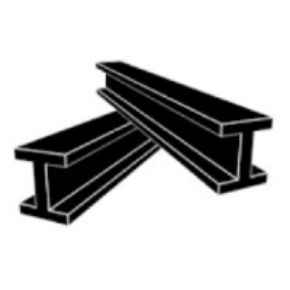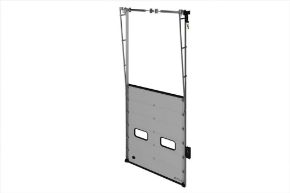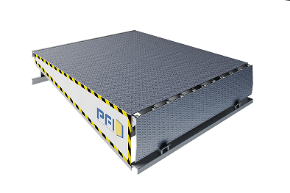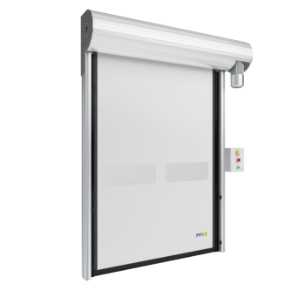What is a Dock Leveler and How Does it Work?
Have you ever wondered how goods and products magically make their way onto the shelves of your favorite stores? If you've ever walked into a warehouse or distribution center and seen trucks being loaded and unloaded, you may have noticed a fascinating piece of equipment known as a dock leveler. Dock levelers play a crucial role in the efficient and safe movement of goods, providing a bridge between the truck and the warehouse floor. In this article, I will guide you through what a dock leveler is and how it works, shedding light on this essential piece of equipment that keeps the supply chain moving smoothly.
When it comes to logistics and distribution, time is of the essence. Every minute wasted in the loading and unloading process translates to potential delays, increased costs, and dissatisfied customers. That's where dock levelers come into play. Picture this: a truck with its cargo pulls up to a warehouse dock, but there is a significant height difference between the truck bed and the floor of the warehouse. How do you bridge that gap seamlessly and efficiently? Enter the dock leveler.
A dock leveler is a mechanical device that serves as a bridge, connecting the truck bed with the warehouse floor. Its primary function is to facilitate the safe and smooth transfer of goods between the truck and the warehouse, ensuring a level surface for the movement of forklifts, pallet jacks, and other equipment. It is an indispensable tool that enables the loading and unloading process to be carried out quickly and efficiently.
Typically, a dock leveler is comprised of three main components: the deck, the lip, and the control system. The deck is a solid plate that rests on the warehouse floor and acts as the platform for both the truck and the forklift. It is capable of supporting heavy loads and provides a stable surface for workers and equipment to move on. The lip is a hinged ramp attached to the front edge of the deck, which extends outward to bridge the gap between the truck and the warehouse floor. When not in use, the lip is stored in a vertical position, flush with the deck. Finally, the control system allows operators to control and adjust the position of the dock leveler, ensuring proper alignment and stability during the loading and unloading process.
So, how does a dock leveler work in practice? When a truck arrives at the warehouse dock, the operator activates the control system to position the dock leveler. This usually involves lowering the deck onto the truck bed, automatically adjusting to the appropriate height. The lip is then extended, forming a bridge between the truck and the warehouse floor. This smooth transition allows forklifts or pallet jacks to easily move between the two surfaces, streamlining the loading and unloading process.
Several types of dock levelers are available, each with its unique set of features and functionalities. The most common types include mechanical dock levelers, hydraulic dock levelers, and air-powered dock levelers. Mechanical dock levelers operate using a spring mechanism that assists in deck positioning and lip extension. Hydraulic dock levelers, on the other hand, use hydraulic cylinders to control the movement of the deck and lip. They provide smooth and effortless operations and are often preferred for high-volume loading docks. Air-powered dock levelers use airbags to raise and lower the deck, offering a reliable and cost-effective solution.
In conclusion, dock levelers are a vital component of the supply chain, ensuring a seamless transfer of goods between trucks and warehouses. By providing a stable and level surface for loading and unloading, they play a crucial role in streamlining operations, reducing the risk of accidents, and increasing overall efficiency. Whether you're a logistics professional or simply curious about the inner workings of the supply chain, understanding the functionality of dock levelers sheds light on the intricate processes behind the scenes - the hidden heroes that keep our shelves stocked and businesses thriving.
Definition of a Dock Leveler
A dock leveler is a mechanical device that serves as a bridge between a loading dock and a truck or trailer. It is designed to facilitate the safe and efficient transfer of goods between two different elevations, ensuring a smooth transition for forklifts, pallet jacks, and other material handling equipment.
Dock levelers are an essential component of any loading dock, as they provide a controlled and secure connection between the facility and the transport vehicle. They are typically installed at the edge of the dock and can be operated manually or automatically, depending on the specific model and requirements of the facility.
The primary function of a dock leveler is to bridge the gap between the dock and the vehicle, allowing forklifts and other equipment to move freely between the two. It eliminates the need for workers to manually lift and carry heavy loads, reducing the risk of injuries and increasing overall productivity.
Dock levelers come in various types and configurations to accommodate different loading dock layouts and weight capacities. The most common types include hydraulic levelers, mechanical levelers, and air-powered levelers.
Hydraulic levelers are the most popular and widely used type. They operate using hydraulic cylinders that extend and retract to raise and lower the leveler platform. These levelers provide smooth and controlled movement, ensuring a safe transition for both personnel and equipment.
Mechanical levelers, on the other hand, use a system of springs and chains to raise and lower the platform. They are typically less expensive than hydraulic levelers but may require more maintenance and have a slower operation speed.
Air-powered levelers use airbags to raise and lower the platform. They are often the preferred choice in food processing and pharmaceutical industries where contamination control is crucial, as they eliminate the risk of hydraulic fluid spills.
Regardless of the type, dock levelers are designed to withstand heavy loads and provide a stable platform for loading and unloading operations. They are typically constructed from durable materials such as steel or aluminum to ensure long-lasting performance and withstand the demands of daily use.
In conclusion, a dock leveler is a crucial component of any loading dock that facilitates the safe and efficient transfer of goods between a facility and a transport vehicle. It provides a bridge between different elevations, enabling forklifts and material handling equipment to move smoothly. With various types and configurations available, dock levelers are designed to withstand heavy loads and provide a stable platform for loading and unloading operations.
Components of a Dock Leveler
A dock leveler is a crucial piece of equipment that helps bridge the gap between a loading dock and a truck or trailer, ensuring the safe and efficient transfer of goods. Understanding the various components of a dock leveler can help provide insight into its functionality and importance in a loading dock environment.
1. Pit Frame: The pit frame is the foundation of the dock leveler system. It is typically made of sturdy steel and is installed below ground level. The pit frame provides structural support and allows for the smooth movement of the dock leveler.
2. Lip and Deck: The lip and deck are the main moving parts of a dock leveler. The deck is a sturdy metal platform that extends from the pit frame out to the trailer or truck. The lip is a hinged plate located at the end of the deck that can be manually or automatically extended and retracted. When the deck is raised to the desired height, the lip extends to bridge the gap between the dock and the trailer.
3. Hydraulic or Mechanical System: Dock levelers are operated either by a hydraulic or mechanical system. Hydraulic systems use hydraulic cylinders and fluid pressure to raise and lower the leveler, while mechanical systems utilize springs and a counterbalance mechanism. These systems are designed to provide smooth and controlled movement of the dock leveler, ensuring safe and efficient operation.
4. Control Panel: A control panel is typically mounted near the loading dock area for easy access. It allows the operator to raise, lower, and control the movement of the dock leveler. Some advanced control panels may feature safety features, such as a lip lock system or a communication interface with the truck or trailer.
5. Safety Features: Dock levelers are equipped with various safety features to prevent accidents and injuries. These may include safety legs or hydraulic velocity fuses that prevent the leveler from collapsing in the event of a trailer separation. Some dock levelers also have automatic lip extension features that ensure the lip is in place before the deck is lowered.
6. Bumpers and Weather Seals: Bumpers are rubber or plastic guards mounted on the dock face to provide a cushioning effect during the loading and unloading process. They help protect the dock leveler and the truck or trailer from damage caused by accidental impacts. Weather seals are typically installed around the sides and top of the dock leveler to prevent drafts, dust, and pests from entering the loading dock area.
Understanding the components of a dock leveler is essential for proper maintenance and operation. Regular inspections and maintenance of these components are necessary to ensure the safe and efficient functioning of the dock leveler system.
Working Mechanism of a Dock Leveler
A dock leveler is a vital component of a loading dock system that bridges the gap between the dock and the trailer, ensuring smooth and efficient loading and unloading of goods. Understanding the working mechanism of a dock leveler is crucial for the safe and effective operation of a loading dock. In this section, I will explain the key components and actions involved in the functioning of a dock leveler.
Components of a Dock Leveler
A typical dock leveler consists of several essential components that work together to facilitate the seamless transfer of goods between the dock and the trailer. These components include:
Lip: The lip is a movable metal plate attached to the end of the dock leveler. It extends out onto the trailer bed, providing a sturdy surface for forklifts or pallet jacks to drive onto.
Hinge Mechanism: The hinge mechanism allows the lip to move up and down, enabling it to adjust to the varying heights of different trailers.
Lip Extension: Some dock levelers come with a lip extension feature, which allows the lip to extend or retract to accommodate trailers of different lengths.
Lifting System: The lifting system is responsible for lifting and lowering the dock leveler. It typically consists of hydraulic cylinders or mechanical springs that support the weight of the dock leveler and ensure smooth vertical movement.
Safety Features: Dock levelers are equipped with various safety features to prevent accidents during operation. These may include safety barriers, safety lips, and safety pins that secure the dock leveler in place.
Working Process
Engagement: To initiate the loading or unloading process, the dock leveler is first engaged with the trailer. This is done by positioning the lip of the dock leveler onto the trailer bed.
Activation: Once engaged, the lifting mechanism of the dock leveler is activated, either manually or electronically. This causes the dock leveler to start rising or lowering, depending on the specific design.
Adjustment: As the dock leveler elevates or descends, the lip adjusts to the height of the trailer bed. This ensures a smooth transition between the dock and the trailer, allowing forklifts or pallet jacks to move goods easily.
Loading and Unloading: With the dock leveler in the correct position, loading or unloading can take place. Forklifts or pallet jacks can drive onto the dock leveler and safely transfer goods between the dock and the trailer.
Retraction: Once the loading or unloading is complete, the dock leveler is retracted by deactivating the lifting mechanism. This brings the lip back to its original position, allowing the trailer to be detached and moved away from the dock.
Safety Measures: Throughout the working process, it is essential to adhere to safety measures. This includes securing the trailer to the dock, ensuring the dock leveler is properly engaged, and using any additional safety features provided.
Understanding the working mechanism of a dock leveler enables loading dock operators and employees to operate the equipment safely and efficiently. It ensures that goods can be transferred between the dock and the trailer smoothly, minimizing the risk of accidents and maximizing productivity.
Advantages of Using a Dock Leveler
As a professional in the logistics and warehousing industry, I have personally experienced the numerous advantages of using a dock leveler. These helpful devices have revolutionized the way goods are loaded and unloaded, providing significant benefits to businesses of all sizes. Below, I will outline some of the key advantages of using a dock leveler:
Efficient loading and unloading: One of the primary advantages of dock levelers is their ability to streamline the loading and unloading process. With a dock leveler, I can easily bridge the gap between the dock and the truck, ensuring seamless movement of goods. This not only saves time but also reduces the risk of accidents and injuries.
Versatile functionality: Dock levelers come in various types and designs, catering to different needs and operational requirements. Whether it's a hydraulic, mechanical, or air-powered dock leveler, there is a solution for every situation. This versatility enables me to handle a wide range of loads, from small parcels to heavy machinery, ensuring maximum efficiency and adaptability.
Improved safety: Safety is a top priority in any warehouse or loading dock setting, and dock levelers play a crucial role in enhancing safety measures. By providing a smooth transition between the dock and the trailer, these devices eliminate dangerous gaps and potential tripping hazards. Additionally, they provide stability and support during the loading and unloading process, reducing the risk of accidents or equipment damage.
Increased productivity: Investing in a dock leveler can significantly boost productivity levels within a warehouse or distribution center. With a dock leveler in place, I can expedite the loading and unloading process, allowing for faster turnaround times. This increased efficiency translates into higher productivity and improved customer satisfaction.
Cost-effective solution: Dock levelers offer a cost-effective solution for businesses, as they minimize the need for additional manual labor or equipment. By providing a safe and efficient loading dock environment, fewer employees are required to handle incoming and outgoing shipments, reducing labor costs. Furthermore, the durability and longevity of dock levelers ensure long-term savings on maintenance and replacement expenses.
Enhanced flexibility: Dock levelers are designed to accommodate different types of trailers and trucks, including those with varying heights and configurations. This flexibility allows me to work with a wide range of vehicles, ensuring compatibility and ease of operation. With adjustable features and customizable options, dock levelers can adapt to changing operational needs, further enhancing their flexibility.
In conclusion, using a dock leveler yields numerous advantages, ranging from increased efficiency and safety to enhanced productivity and cost-effectiveness. These innovative devices have become an indispensable asset in the logistics and warehousing industry, providing businesses with the tools they need to optimize their loading dock operations. Whether you operate a small warehouse or a large distribution center, investing in a dock leveler is a wise decision that will yield significant benefits in the long run.
Considerations When Choosing a Dock Leveler
When selecting a dock leveler for your facility, there are several important considerations to keep in mind. The right dock leveler can greatly enhance safety, efficiency, and productivity in your loading and unloading operations. Here are some key factors to consider when choosing a dock leveler:
Weight Capacity: One of the most critical considerations is the weight capacity of the dock leveler. It must be able to handle the maximum load that will be transported across it. Determining the average weight of your heaviest loads and selecting a dock leveler with a higher weight capacity can help ensure it can handle any potential load demands.
Installation: Dock levelers come in different types and installation styles, such as pit-style or surface-mounted. Consider the available space and building structure to determine which installation type is most suitable for your needs. Factors such as the pit dimensions, required concrete work, and any obstacles present should be taken into account during the installation process.
Size and Dimensions: The size and dimensions of the dock leveler are crucial for a seamless loading and unloading process. Ensure that the dock leveler matches the width and length of your loading dock, truck height variations, and the size of the loads being transported. It should accommodate a range of vehicles and cargo sizes to maximize flexibility.
Safety Features: Safety should be a top priority when choosing a dock leveler. Look for safety features such as safety legs, which provide support in the event of a truck separation, and automatic lip extension, which prevents tripping hazards. Additionally, consider features like non-slip platforms, reflective markings, and audible alarms to promote safer operations.
Durability and Maintenance: A dock leveler should be built to withstand heavy usage and harsh environmental conditions. Consider the materials used in its construction, such as steel or aluminum, for durability and corrosion resistance. Additionally, inquire about maintenance requirements and the availability of replacement parts to ensure the dock leveler can be easily serviced if needed.
Efficiency and Productivity: The dock leveler should contribute to a smooth and efficient workflow. Look for features like hydraulic operation for quick and precise height adjustment, fast cycle times, and smooth transition between the dock and trailer to minimize downtime and increase productivity.
Budget: Finally, consider your budget when selecting a dock leveler. There is a wide range of options available, each with different features and price points. Determine the features that are essential for your specific needs and consider the long-term value and return on investment when evaluating various options.
By carefully considering these factors, you can choose a dock leveler that meets your requirements and enhances the efficiency and safety of your loading and unloading operations. Investing in the right dock leveler can result in improved productivity, reduced maintenance costs, and a safer working environment for your employees.












